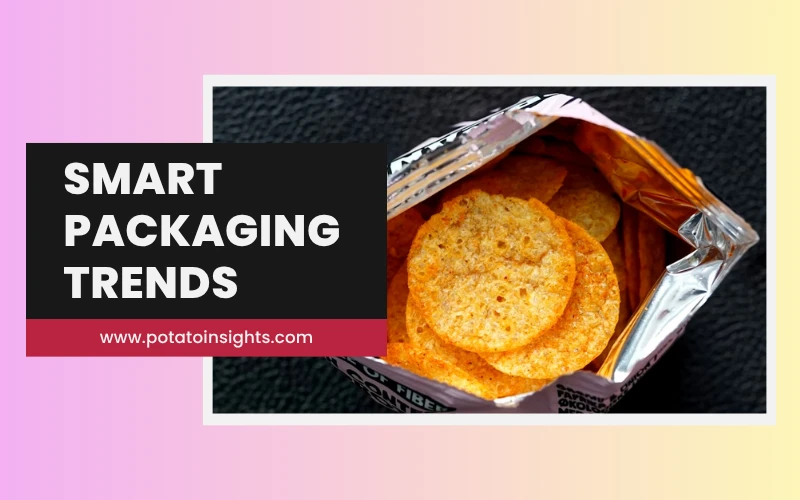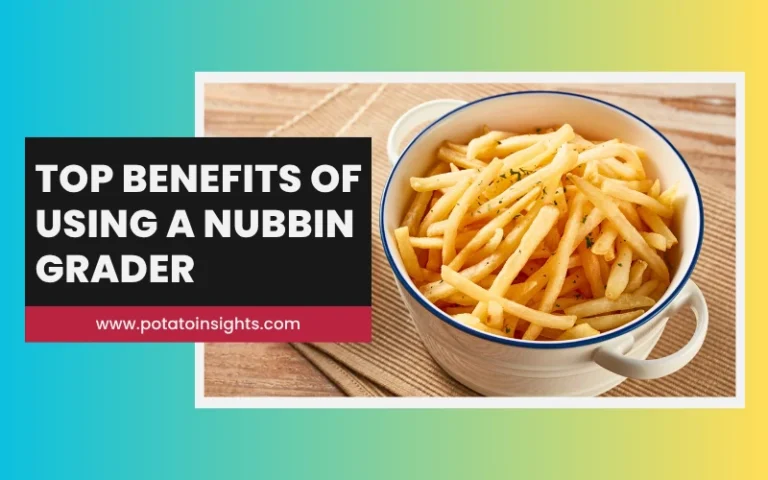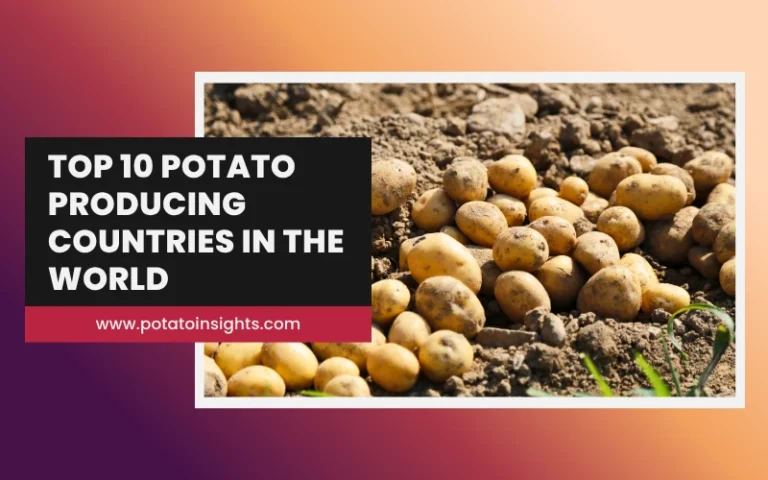
Potato chips and snacks travel long distances before reaching stores. In many markets, people want fresh taste, clean packs, longer shelf life and clear information about what they are buying. Snack brands now use smart packaging to handle these needs.
These new methods are not limited to large brands. Many mid-size and small plants also use simple forms of smart packaging to stay in the market.
This blog explains the main smart packaging trends that are moving the global snack sector forward. The aim is to share clear points so any reader can understand how these changes help snack makers, sellers and buyers.
1. Freshness Indicators for Real-Time Quality Checks
Freshness indicators are small printed tags or labels on packs that show the state of the product. Some change color when air or moisture enters the pack, while others respond when the pack is stored at the wrong temperature.
A study from a global packaging group showed that color-change freshness tags cut return rates by 7–12% for trial snack batches in Asia and Europe.
Why this matters
- People can see pack condition without opening it.
- Brands get fewer complaints about stale chips.
- It helps during transport when temperature varies.
Impact on speed
Workers in warehouses spend less time checking packs manually. This leads to faster sorting and dispatch during busy weeks.
2. QR Codes That Share Product Details
QR codes are now common on many snack packs. They link buyers to short videos, recipes, or simple info pages. Large brands use them to share ingredient lists, factory details, or batch dates.
A survey by a global food-tech firm in 2023 found that around 40% of snack buyers scanned QR codes when printed near the nutrition label. This helped brands get direct feedback on taste and pack quality.
Quality impact
- Buyers feel more trust when they can check batch data.
- Brands can fix issues quickly because they get fresh feedback.
Speed impact
- Faster complaint tracking.
- Quick recall actions if needed.
Also read: Top Benefits of Using a Nubbin Grader for Potatoes French Fries
3. MAP Packs for Longer Shelf Life
MAP means Modified Atmosphere Packaging. It replaces normal air with a clean gas mix that slows down oxidation and moisture damage. Potato chips last longer when oxygen is low and moisture is controlled. Many plants now use nitrogen flushing to keep the chips crisp.
A European snack study reported that MAP extended shelf life by 20–45% compared to normal air-filled packs.
Why this matters
- Chips taste fresh for longer.
- Fewer packs go to waste.
- Better long-distance transport support.
Speed gain
- Retailers spend less time checking expiry dates.
- Fewer rejects at loading points.
4. Smart Barcodes for Tracking Inventory
Smart barcodes use simple printed tech that lets scanners pick up more details per pack. These can carry batch time, production line number and pack weight in one small code.
Large snack plants in the US and UK reported that smart barcodes reduced sorting time by 25–30%, which helped during peak seasons.
Quality impact
- Better tracking of faulty batches.
- Clear trace data during audits.
Speed impact
- Faster stock counts.
- Quick warehouse movement.
5. Anti-Tamper Seals for Pack Safety
Many snack companies now add small transparent seals that show if a pack was opened earlier. These seals are simple yet strong enough to reveal any attempt to open the pouch.
One global survey of FMCG brands noted that anti-tamper seals cut pack-related complaints by 10–15% in retail chains.
Quality gain
- Buyers trust sealed packs.
- Sellers face fewer returns.
Speed gain
- Faster shelf checks in stores.
- Quick sorting at dispatch points.
6. Recyclable and Light Packs for Cleaner Use
Many brands are shifting to single-material film, paper-film blends, or thinner plastic rolls. These packs reduce waste and keep the pack weight low.
A packaging report from 2023 showed that light packs cut material cost by 5–12% for large snack brands.
Quality gain
- Packs stay firm.
- Chips stay crisp due to better moisture control.
Speed gain
- Faster packing due to lighter rolls.
- Quick sealing on modern machines.
7. RFID Tags for High-Volume Logistics
RFID tags help track pallets and cartons using radio signals. They are used more in large plants or export units. RFID helps trace each pallet from the plant to the retailer.
Large global snack companies say RFID tracking saved up to 18% in logistics losses and cut manual checking time by 30–40%.
Quality impact
- Better tracking of batches.
- Quick action during stock issues.
Speed impact
- Faster loading and unloading.
- Smooth warehouse flow.
8. Oxygen Scavenger Sachets
These are small packets placed inside the outer cardboard boxes or secondary packs. They help control the oxygen level in the space outside the pouch but inside the carton. This reduces the risk of chips losing crispness during long shipping.
Many Asian snack brands report 15–20% fewer stale complaints when using oxygen scavengers in export cartons.
Quality gain
- Less oxidation.
- More stable taste.
Speed gain
- Longer shelf life means fewer returns.
- Less repacking work during distribution.
Also read: Top 10 Potato Producing Countries in the World (2025)
9. Temperature-Tracking Labels for Cold Regions
Some snacks travel through cold climates or variable storage areas. Temperature-tracking labels record if the product crosses a certain temperature point.
This helps plants understand where damage occurs, especially when sending chips to high-altitude or cold regions.
A 2022 packaging study found that such labels reduced damage claims by 9–11% for mixed snack loads.
Quality impact
- Better insight into shipping issues.
- Higher chance of fresh-tasting chips on arrival.
Speed impact
- Faster sorting during imports and exports.
- Quick scan-based checking at warehouses.
10. Smart Pack Printing for Batch Control
Many plants now use thermal or laser printing machines that place clear, smudge-free batch codes on packs. Clear codes help retailers check shelf life more easily.
A retail study from 2023 found that clear batch printing reduced barcode scanning errors by 20–25%.
Quality impact
- Trustworthy labeling.
- Easy audits for factories and stores.
Speed impact
- Faster checkout scanning.
- Smoother warehouse handling.
Conclusion
Smart packaging is changing the way potato chips and snacks move from plants to buyers. Some changes are simple and low-cost, while others use more advanced tools. Each one helps in its own way. Freshness stays better, packs last longer and workers spend less time checking stock.
As snack demand grows in many countries, more brands will turn to these methods. This helps them stay strong in the market and offer cleaner, safer and longer-lasting packs to buyers.
Frequently Asked Questions (FAQs)
-
Why are brands using smart packaging now?
Because it helps improve freshness, safety and tracking while keeping costs under control.
-
Do all smart packaging tools cost a lot?
No. Some options like QR codes or light films are low-cost and easy to use.
-
Does smart packaging help with exports?
Yes. It helps with tracking, shelf life and damage control during long shipping.
-
Are freshness indicators common?
They are growing in many regions, especially among larger snack brands.
-
Can small plants use smart packaging?
Yes. Simple steps like QR codes, clean batch printing and light films work well for small plants.
Research Sources:
- “Active and Intelligent Packaging Market Report” — Smithers
- “Flexible Packaging Trends Report” — Flexible Packaging Association
- “Smart Packaging for Food and Drink” — IDTechEx
- “Global Snack Food Market Review” — MarketWatch
Follow us to receive updates🔔



